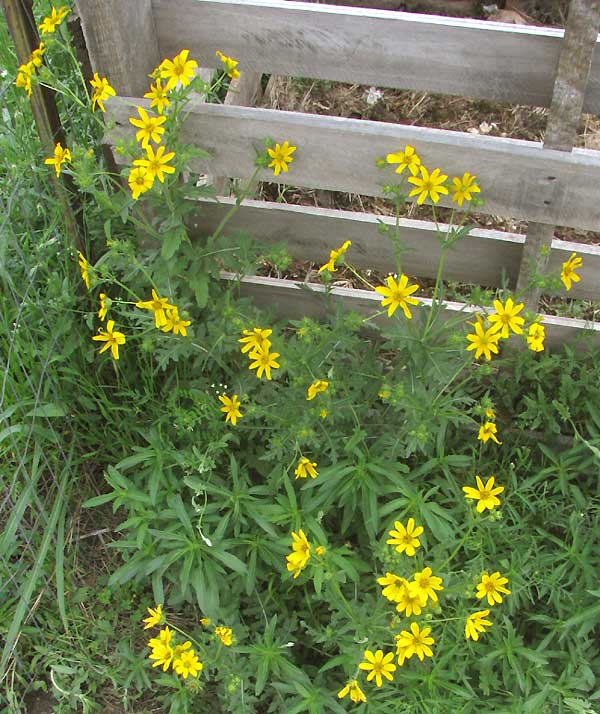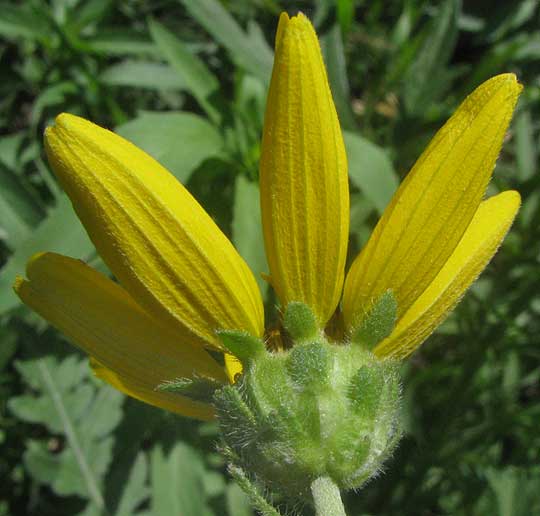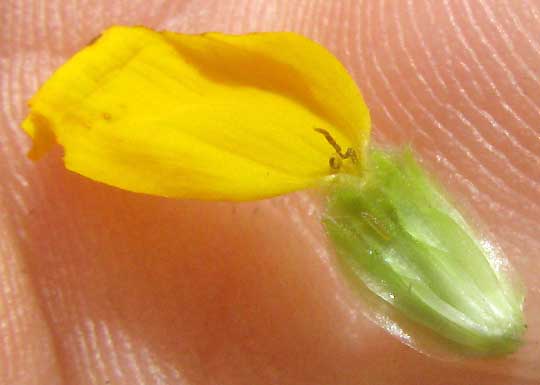Excerpts from Jim Conrad's
Naturalist Newsletter

from the the May 5, 2013 Newsletter issued from the Frio Canyon Nature Education Center in northern Uvalde County, southwestern Texas, on the southern border of the Edwards Plateau; elevation ~1750m (~5750 ft); N29.62°, W99.86°; USA
ENGELMANN'S DAISIES
According to the map on the USDA's "U.S. Drought Monitor" page, we are on the boundary between experiencing an "extreme drought" and an "exceptional drought," an exceptional drought being more extreme than an extreme one. Maybe that explains why locals tell me that normally at this time of year the Dry Frio Valley is resplendent with many kinds of blossoming wildflower, though this year mostly we have slowly greening grass, with only a few wildflowers here and there.
However, next to my compost bin, which I keep watered so the bacteria breaking down my organic matter don't get thirsty, maybe there's a hint of what the valley would be like if we were receiving our normal rainfall amounts. You can see it for yourself at the top of this page.
The slender leaves amidst the blossoms belong to another plant, for many species otherwise not appearing in the area cluster around that compost heap. One of the large, deeply lobed leaves of our blossoming compost plant is shown below:

The blossoms are clearly those of the Daisy or Composite Family, the Asteraceae. According to the online Flora of North America, the Daisy Family embraces 418 genera with 2413 species, and thus is the largest, most diverse of all of North America's flowering plant families. A lot of those 2413 species are very similar to our yellow-flowered compost daisy, so once again we have to start looking for good field marks.

Right off, as seen above, the flower head's green, bowl-shaped "involucre" at the flower head's bottom is unusual because the scales, or phyllaries, covering it are arranged in three series and each phyllary's tip is thick, dark green, and rounded. More typical phyllaries are sharp-pointed and not thickened at their tip, and are arranged in several series, or maybe just one, but not like this. Also, notice how the top phyllaries each subtend a yellow ray-flower.

Above a broken-apart head reveals that the disk flowers in the blossom's "eye" are separated from one another by greenish, hairy scales known as paleae. Many Daisy Family genera don't produce paleae, so this is something important to notice.
Even more important in that picture, however, is to notice that the bottom part of each disc flower looks rather undeveloped. The bottom parts of Daisy Family disc flowers normally develop into achene-like fruits known nowadays as cypselae. No fruits seem to be forming at these disc flowers' bases. When you see such vestigial disc flower fruits you need to see if maybe the future cypselae are developing at the bottom of the ray flowers along the head's margin. In fact, that's the case with this plant. You can see a ray flower removed with its greenish, immature cypsela below:

A very unusual feature of this species is that when the cypsela is mature, instead of falling alone as a sunflower "seed" might -- sunflower seeds are actually cypsela fruits -- each cypsela falls attached to the scale-like phyllary below it, as well as with two to four paleae, and even with the sterile ovaries of two to four diss flowers. I can't recall seeing anything like this in a lifetime of looking at daisy-type flowers.
These special features along with some others all help identify the compost-bin plant as Engelmann's Daisy, ENGELMANNIA PERISTENIA, a species that is so unlike other members of the Daisy Family that the genus Engelmannia is "monotypic" -- in the whole world the genus contains only this one species. The species occurs mostly in the south-central US states, but as far north as South Dakota, and into arid northern Mexico.
Around here ranchers consider the Engelmann's Daisy an "ice cream plant" for their cattle, since livestock love to eat it -- they go right for it when they see it. That's one reason why the species is missing over large areas here, but turns up along roads and people's backyards where cattle can't get to.